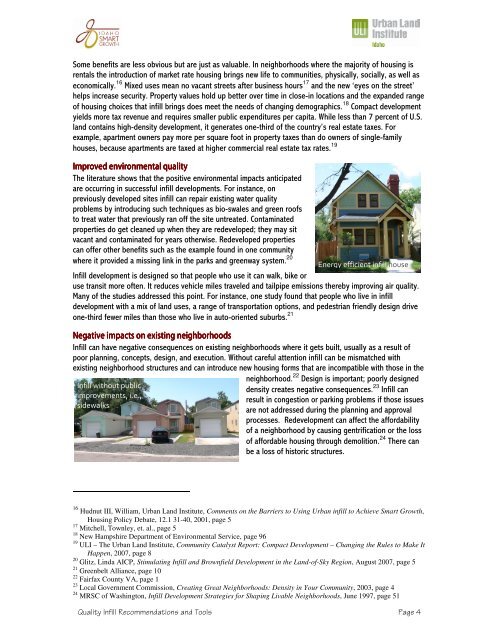Quality Infill Quality Infill - Idaho Smart Growth
Quality Infill Quality Infill - Idaho Smart Growth
Quality Infill Quality Infill - Idaho Smart Growth
Create successful ePaper yourself
Turn your PDF publications into a flip-book with our unique Google optimized e-Paper software.
Some benefits are less obvious but are just as valuable. In neighborhoods where the majority of housing is<br />
rentals the introduction of market rate housing brings new life to communities, physically, socially, as well as<br />
economically. 16 Mixed uses mean no vacant streets after business hours 17 and the new ‘eyes on the street’<br />
helps increase security. Property values hold up better over time in close-in locations and the expanded range<br />
of housing choices that infill brings does meet the needs of changing demographics. 18 Compact development<br />
yields more tax revenue and requires smaller public expenditures per capita. While less than 7 percent of U.S.<br />
land contains high-density development, it generates one-third of the country’s real estate taxes. For<br />
example, apartment owners pay more per square foot in property taxes than do owners of single-family<br />
houses, because apartments are taxed at higher commercial real estate tax rates. 19<br />
Improve mprove mproved mprove environmental quality quality<br />
The literature shows that the positive environmental impacts anticipated<br />
are occurring in successful infill developments. For instance, on<br />
previously developed sites infill can repair existing water quality<br />
problems by introducing such techniques as bio-swales and green roofs<br />
to treat water that previously ran off the site untreated. Contaminated<br />
properties do get cleaned up when they are redeveloped; they may sit<br />
vacant and contaminated for years otherwise. Redeveloped properties<br />
can offer other benefits such as the example found in one community<br />
where it provided a missing link in the parks and greenway system. 20<br />
<strong>Infill</strong> development is designed so that people who use it can walk, bike or<br />
use transit more often. It reduces vehicle miles traveled and tailpipe emissions thereby improving air quality.<br />
Many of the studies addressed this point. For instance, one study found that people who live in infill<br />
development with a mix of land uses, a range of transportation options, and pedestrian friendly design drive<br />
one-third fewer miles than those who live in auto-oriented suburbs. 21<br />
Energy efficient infill house<br />
Negative Negative impacts impacts on on existing existing neighborhoods<br />
neighborhoods<br />
<strong>Infill</strong> can have negative consequences on existing neighborhoods where it gets built, usually as a result of<br />
poor planning, concepts, design, and execution. Without careful attention infill can be mismatched with<br />
existing neighborhood structures and can introduce new housing forms that are incompatible with those in the<br />
<strong>Infill</strong> without public<br />
improvements, i.e.,<br />
sidewalks<br />
neighborhood. 22 Design is important; poorly designed<br />
density creates negative consequences. 23 <strong>Infill</strong> can<br />
result in congestion or parking problems if those issues<br />
are not addressed during the planning and approval<br />
processes. Redevelopment can affect the affordability<br />
of a neighborhood by causing gentrification or the loss<br />
of affordable housing through demolition. 24 There can<br />
be a loss of historic structures.<br />
16<br />
Hudnut III, William, Urban Land Institute, Comments on the Barriers to Using Urban infill to Achieve <strong>Smart</strong> <strong>Growth</strong>,<br />
Housing Policy Debate, 12.1 31-40, 2001, page 5<br />
17<br />
Mitchell, Townley, et. al., page 5<br />
18<br />
New Hampshire Department of Environmental Service, page 96<br />
19<br />
ULI – The Urban Land Institute, Community Catalyst Report: Compact Development – Changing the Rules to Make It<br />
Happen, 2007, page 8<br />
20<br />
Glitz, Linda AICP, Stimulating <strong>Infill</strong> and Brownfield Development in the Land-of-Sky Region, August 2007, page 5<br />
21<br />
Greenbelt Alliance, page 10<br />
22<br />
Fairfax County VA, page 1<br />
23<br />
Local Government Commission, Creating Great Neighborhoods: Density in Your Community, 2003, page 4<br />
24<br />
MRSC of Washington, <strong>Infill</strong> Development Strategies for Shaping Livable Neighborhoods, June 1997, page 51<br />
<strong>Quality</strong> <strong>Infill</strong> Recommendations and Tools Page 4


